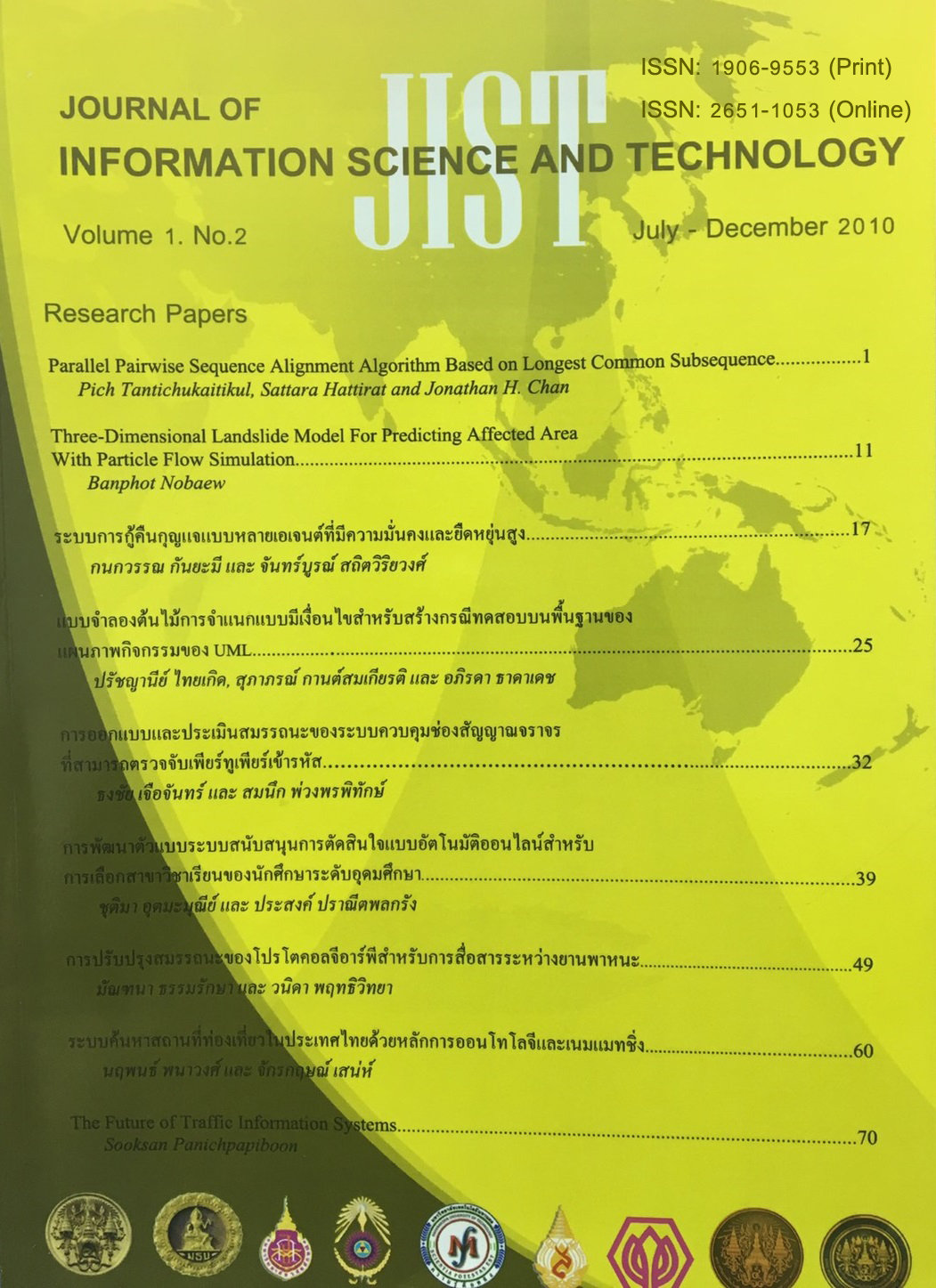Three-Dimensional Landslide Model For Predicting Affected Area With Particle Flow Simulation
Main Article Content
Abstract
- Landslides are a serious natural disaster in many countries around the world especially in highland areas during the rainy season. Therefore an early warning system which can predict the possibility of landslide in hazard areas is seriously required to prevent damage to life and assets. Three-dimensional models are also needed to simulate landslide areas for prediction of the overall effects. This paper describes a new three-dimensional landslide model by applying a methodology consisting of image processing, use of global positioning system, and risk factor interaction on programming. A landslide model is built by contouring the surveyed sites. In addition, a 3D Studio MAX script is employed based on existing risk factors to simulate the flow of land particles during the occurrence of a landslide. Based on observations of the landslide site, the proposed method shows acceptable accuracy on both the probability of landslide incident and its effects.
Article Details
This work is licensed under a Creative Commons Attribution-NonCommercial-NoDerivatives 4.0 International License.
I/we certify that I/we have participated sufficiently in the intellectual content, conception and design of this work or the analysis and interpretation of the data (when applicable), as well as the writing of the manuscript, to take public responsibility for it and have agreed to have my/our name listed as a contributor. I/we believe the manuscript represents valid work. Neither this manuscript nor one with substantially similar content under my/our authorship has been published or is being considered for publication elsewhere, except as described in the covering letter. I/we certify that all the data collected during the study is presented in this manuscript and no data from the study has been or will be published separately. I/we attest that, if requested by the editors, I/we will provide the data/information or will cooperate fully in obtaining and providing the data/information on which the manuscript is based, for examination by the editors or their assignees. Financial interests, direct or indirect, that exist or may be perceived to exist for individual contributors in connection with the content of this paper have been disclosed in the cover letter. Sources of outside support of the project are named in the cover letter.
I/We hereby transfer(s), assign(s), or otherwise convey(s) all copyright ownership, including any and all rights incidental thereto, exclusively to the Journal, in the event that such work is published by the Journal. The Journal shall own the work, including 1) copyright; 2) the right to grant permission to republish the article in whole or in part, with or without fee; 3) the right to produce preprints or reprints and translate into languages other than English for sale or free distribution; and 4) the right to republish the work in a collection of articles in any other mechanical or electronic format.
We give the rights to the corresponding author to make necessary changes as per the request of the journal, do the rest of the correspondence on our behalf and he/she will act as the guarantor for the manuscript on our behalf.
All persons who have made substantial contributions to the work reported in the manuscript, but who are not contributors, are named in the Acknowledgment and have given me/us their written permission to be named. If I/we do not include an Acknowledgment that means I/we have not received substantial contributions from non-contributors and no contributor has been omitted.
References
2. G. Venkatachalam, M. Nagesha, and G. Dodagoudar, “Landslide modelling using remote sensing and GIS,” Geoscience and Remote Sensing Symposium, 2002. IGARSS '02. 2002 IEEE International, 2002, pp. 2045-2047 vol.4.
3. J. Wang and X. Peng, “GIS-based landslide hazard zonation model and its application,” Procedia Earth and Planetary Science, vol. 1, Sep. 2009, pp. 1198-1204.
4. International Institute for Geo-Information Science and Earth Observation, “Statistical landslide hazard analysis”,Netherlands, http://www.itc.nl/ilwis/applications, 2007.
5. A. Carrara, F. Guzzetti, M. Cardinali, and P. Reichenbach, Use of GIS Technology in the Prediction and Monitoring of Landslide Hazard. Natural Hazards, vol. 20, Nov. 1999, pp. 117-135.



